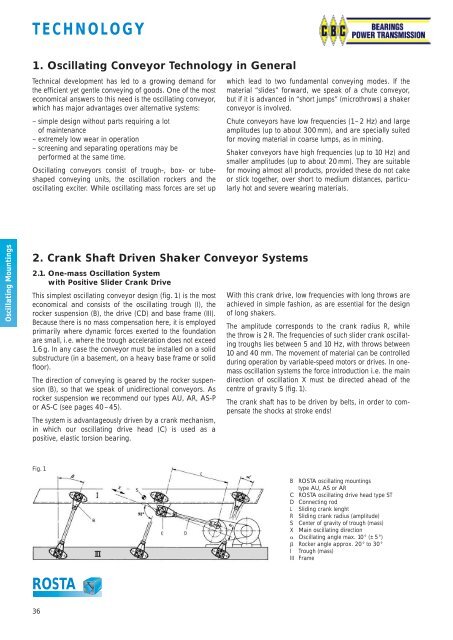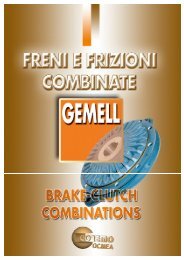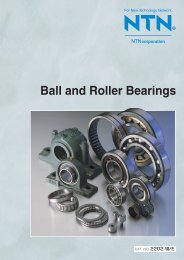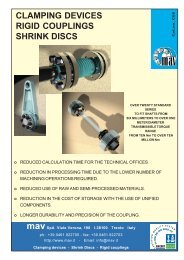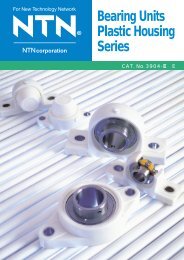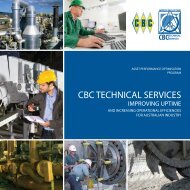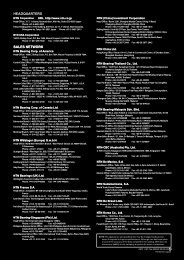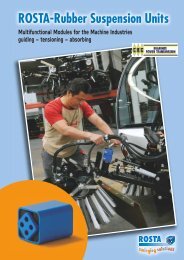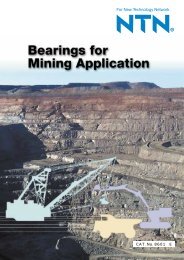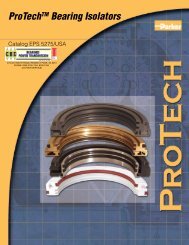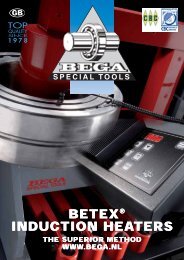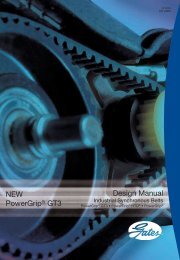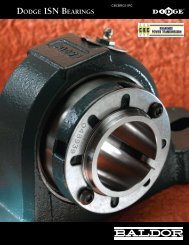Oscillating Mountings
Oscillating Mountings
Oscillating Mountings
You also want an ePaper? Increase the reach of your titles
YUMPU automatically turns print PDFs into web optimized ePapers that Google loves.
TECHNOLOGY<br />
1. <strong>Oscillating</strong> Conveyor Technology in General<br />
Technical development has led to a growing demand for<br />
the efficient yet gentle conveying of goods. One of the most<br />
economical answers to this need is the oscillating conveyor,<br />
which has major advantages over alternative systems:<br />
– simple design without parts requiring a lot<br />
of maintenance<br />
– extremely low wear in operation<br />
– screening and separating operations may be<br />
performed at the same time.<br />
<strong>Oscillating</strong> conveyors consist of trough-, box- or tubeshaped<br />
conveying units, the oscillation rockers and the<br />
oscil lating exciter. While oscillating mass forces are set up<br />
which lead to two fundamental conveying modes. If the<br />
material “slides” forward, we speak of a chute conveyor,<br />
but if it is advanced in “short jumps” (microthrows) a shaker<br />
conveyor is involved.<br />
Chute conveyors have low frequencies (1– 2 Hz) and large<br />
amplitudes (up to about 300 mm), and are specially suited<br />
for moving material in coarse lumps, as in mining.<br />
Shaker conveyors have high frequencies (up to 10 Hz) and<br />
smaller amplitudes (up to about 20 mm). They are suit able<br />
for moving almost all products, provided these do not cake<br />
or stick together, over short to medium distances, particularly<br />
hot and severe wearing materials.<br />
<strong>Oscillating</strong> <strong>Mountings</strong><br />
2. Crank Shaft Driven Shaker Conveyor Systems<br />
2.1. One-mass Oscillation System<br />
with Positive Slider Crank Drive<br />
This simplest oscillating conveyor design (fig. 1) is the most<br />
economical and consists of the oscillating trough (I), the<br />
rocker suspension (B), the drive (CD) and base frame (III).<br />
Because there is no mass compensation here, it is employed<br />
primarily where dynamic forces exerted to the foundation<br />
are small, i.e. where the trough acceleration does not exceed<br />
1.6 g. In any case the conveyor must be in stalled on a solid<br />
substructure (in a basement, on a heavy base frame or solid<br />
floor).<br />
The direction of conveying is geared by the rocker suspension<br />
(B), so that we speak of unidirectional conveyors. As<br />
rocker suspension we recommend our types AU, AR, AS-P<br />
or AS-C (see pages 40–45).<br />
The system is advantageously driven by a crank mechan ism,<br />
in which our oscillating drive head (C) is used as a<br />
positive, elastic torsion bearing.<br />
With this crank drive, low frequencies with long throws are<br />
achieved in simple fashion, as are essential for the design<br />
of long shakers.<br />
The amplitude corresponds to the crank radius R, while<br />
the throw is 2 R. The frequencies of such slider crank oscillat -<br />
ing troughs lies between 5 and 10 Hz, with throws between<br />
10 and 40 mm. The movement of material can be controlled<br />
during operation by variable-speed motors or drives. In onemass<br />
oscillation systems the force introduction i.e. the main<br />
direction of oscillation X must be directed ahead of the<br />
centre of gravity S (fig. 1).<br />
The crank shaft has to be driven by belts, in order to compensate<br />
the shocks at stroke ends!<br />
Fig. 1<br />
B ROSTA oscillating mountings<br />
type AU, AS or AR<br />
C ROSTA oscillating drive head type ST<br />
D Connecting rod<br />
L Sliding crank lenght<br />
R Sliding crank radius (amplitude)<br />
S Center of gravity of trough (mass)<br />
X Main oscillating direction<br />
<strong>Oscillating</strong> angle max. 10° (± 5°)<br />
Rocker angle approx. 20° to 30°<br />
I Trough (mass)<br />
III Frame<br />
ROSTA<br />
36


